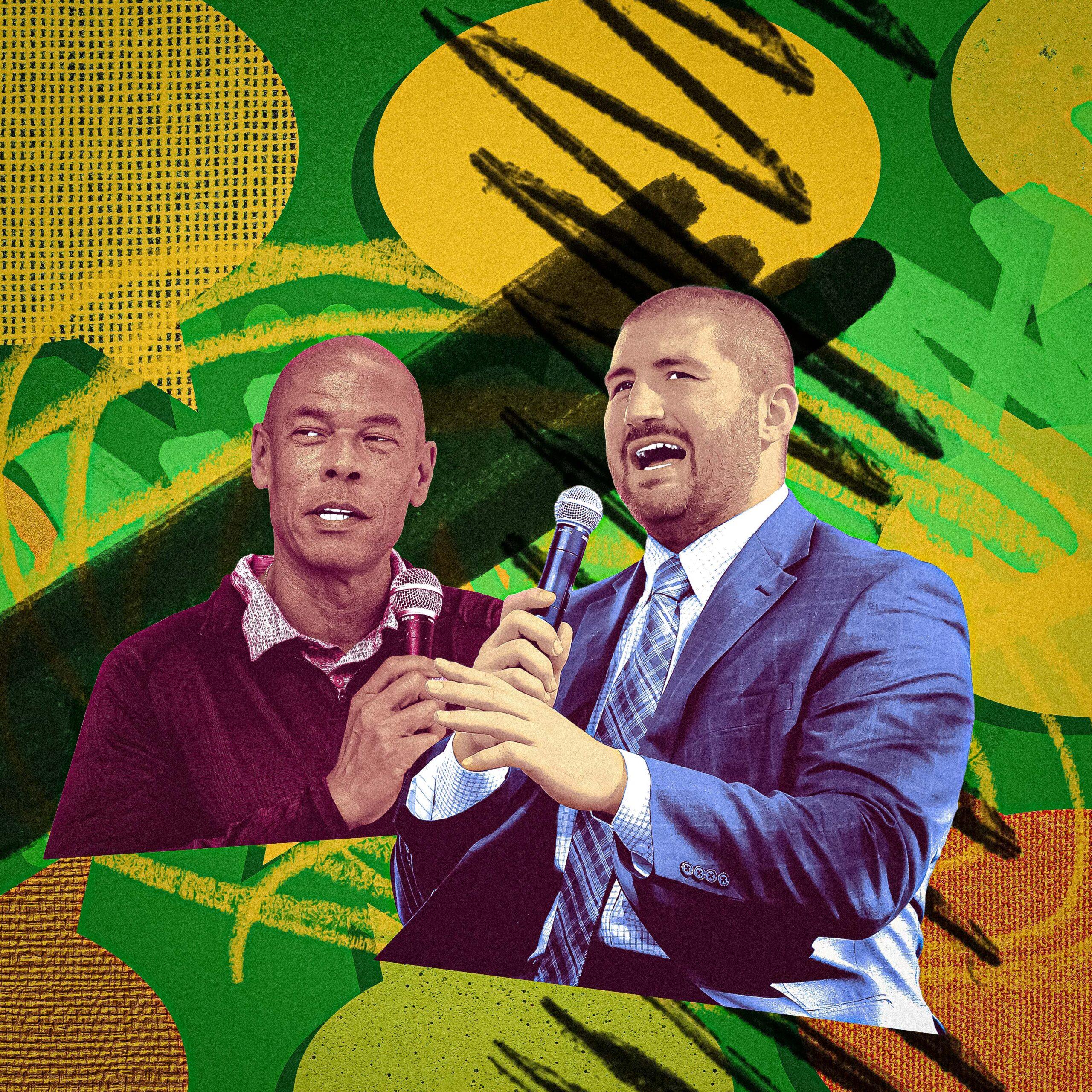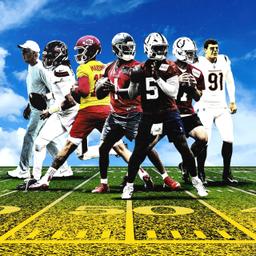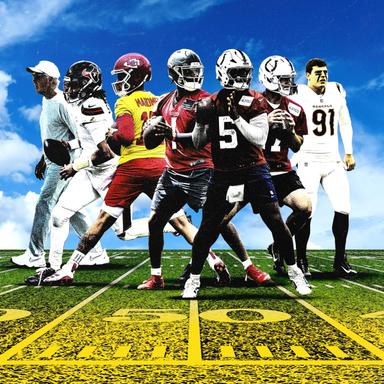
The NFL Players Association is in a state of chaos. In the past week, the union’s executive director, Lloyd Howell Jr., and chief strategy officer, J.C. Tretter, each resigned, leaving a massive leadership void atop the NFLPA on the eve of the preseason. The resignations came after a series of podcasts and news stories—first from journalist Pablo Torre and Pro Football Talk’s Mike Florio, and later from ESPN—exposed secretive agreements between the union and the NFL, Howell’s conflicts of interest while serving as the union’s leader, and overall dysfunction behind the scenes of the NFLPA.
As of Wednesday morning, no interim director had been named, and it is unlikely a vote will happen by the end of the week. So while the union’s executive committee figures out who it wants as its temporary leader—and also determines what the process will be for choosing the permanent director who will lead the NFLPA into negotiations on the next collective bargaining agreement—let’s look back at how the union ended up in this mess. Here’s what you need to know.
How did we get here?
Journalism works! Last month, Torre dropped a bombshell report stating that the NFL and the NFLPA had worked together to keep the findings of an arbitration claim secret. The union’s initial claim, which had been filed by the previous executive director, DeMaurice Smith, in October 2022, came after a number of prominent veteran quarterbacks failed to secure fully guaranteed contracts in the months following Deshaun Watson’s historic five-year, $230 million deal with the Browns. The NFLPA believed NFL owners colluded to limit the amount of guarantees in contracts for players like Kyler Murray and Russell Wilson. The arbitrator dismissed the union’s overall claim of collusion—but revealed that at the NFL’s annual meetings in March 2022, the league’s management council, with approval from commissioner Roger Goodell, did encourage teams to work together to reduce the amount of guaranteed money offered to players.
I was at those league meetings in Palm Beach in the weeks after Watson’s monumental deal, and I remember feeling pretty grossed out that so many team owners and executives seemed unhappy with the Browns—not because they had just traded for and handed that contract to a player who had dozens of pending civil lawsuits from women who said he had committed sexual misconduct during massage appointments, but because of the precedent the Browns had set with the fully guaranteed deal.
The most notable part of Torre’s reporting wasn’t that the league was encouraging ownership to suppress player salaries. It was that the union had agreed to keep the arbitrator’s finding a secret—hiding it not just from the general public but from its own members, the players, as well.
Even if the union didn’t ultimately win its claim, getting an independent arbitrator to confirm that collusion-y business was afoot was the type of PR win you’d think the NFLPA would have wanted to broadcast. It’s still unclear exactly why Howell agreed to keep the ruling secret—and who else in the union was even privy to the findings—but the revelation of a hush-hush agreement with the league opened the floodgates to questions about what else was going on behind the scenes during Howell’s tenure at the NFLPA.
A series of stories from ESPN soon followed, which stated that Howell had:
- been sued for sexual discrimination and retaliation while at Booz Allen Hamilton;
- been working since March 2023 in a part-time paid role as a consultant for the Carlyle Group, a private equity firm that in 2024 was approved by the league to invest in NFL franchises;
- had twice charged the union for trips he made to strip clubs. Howell expensed car service to a strip club in Miami and expensed cash withdrawals from an ATM during a visit to Magic City in Atlanta with other union members.
Additionally, the FBI has been investigating both the NFLPA and Major League Baseball Players Association’s relationships with OneTeam Partners—a licensing group co-owned by multiple pro sports unions that allows players to make money off their name, image, and likeness—to determine whether union officials like Howell, who was on the board of OneTeam, would be in a position to enrich themselves. According to The Athletic, the full scope of the FBI’s probe is unclear.
Howell resigned on the evening of July 17, the day before ESPN published its report about the strip clubs, saying in a statement that his “leadership has become a distraction to the important work the NFLPA advances every day.”
Howell’s resignation kicked off a search for an interim executive director to lead the union until a permanent replacement could be found. According to multiple reports, Tretter immediately emerged as a candidate for that job, with some support from players on the executive board he had recently led.
But Tretter was facing intense scrutiny, as well. Also on July 17, Torre reported that in another previously secret ruling, an arbitrator found that Tretter had violated the collective bargaining agreement in 2023 when he made a comment that running backs could “exaggerate” injuries as a way to create leverage in contract disputes. As Tretter’s candidacy for interim director gained steam late last week, several former players spoke out against him on social media, while The Boston Globe reported that a text message critical of Tretter was being shared among players.
On Sunday night, Tretter announced that he would be leaving his role in the union.
So, who are Lloyd Howell and J.C. Tretter?
Howell was elected as the union’s fourth-ever executive director in June 2023 following a lengthy career as a financial executive and management consultant at Washington, D.C.-based defense contract firm Booz Allen Hamilton. He arrived at the NFLPA without experience working in labor relations or in football, and he was elected after a yearlong, highly secretive search for a successor for Smith, who led the union from 2009 to 2023. (Smith’s predecessor, former player Gene Upshaw, led the NFLPA from 1983 until his death in 2008.)
Tretter led the unconventional search (one that was criticized at the time) that resulted in Howell’s election. And Tretter and a handful of other players on the executive committee, including Richard Sherman, Calais Campbell, and Austin Ekeler, vetted candidates but kept their names secret from the broader group of player representatives until it was time to vote. Tretter told CBS Sports on Sunday that the executive board overwhelmingly preferred the other finalist, David White, an executive with SAG-AFTRA, but they didn’t provide that information to the larger voting body.
Tretter studied labor relations at Cornell and spent eight years playing center in the NFL, with the Green Bay Packers and Cleveland Browns. He was elected as the NFLPA player president in 2020, and Tretter and Smith were the faces and voices of the union throughout the COVID-19 pandemic. During his tenure as president, he focused on trying to reform the league’s offseason program, led an organized effort from players to push for grass fields instead of turf, and tried to amend the media policy for players. He is also credited with creating the popular and effective annual report card for NFL franchises. Tretter retired from playing after the 2022 season and as such was ineligible to run for a second term as president. Last year, Howell formally brought Tretter back to the NFLPA in a newly created role as chief strategy officer.
Torre reported on his podcast, Pablo Torre Finds Out, that Tretter was trying to amass power in the union, with the ultimate goal of becoming executive director. (Upon announcing his resignation, Tretter told CBS Sports he was not interested in that job, on either an interim or permanent basis.)
Where does that leave the NFLPA now?
The union is clearly in a state of flux, and these departures—as bad as they look on the outside—offer the NFLPA a chance for a major reset. The union now has a chance for a redo and to find the right executive director—something it’ll need in an upcoming labor battle against the NFL. Howell was seemingly picked for his business acumen and demeanor; in terms of personality, he was more mild-mannered than his predecessor, Smith, a lawyer who was often up for a public fight. But now players might have an example of the type of leader they don’t want—and that’s one who downplays his own conflicts of interest and is willing to cozy up to Goodell and league executives.
So what do they want? Someone with a legal background? Is prior labor relations experience a must? Will the ideal candidate have previous experience working within the NFLPA? Should the next executive director have a background in football, perhaps as a former player?
To me, one thing is clear as the search for new union leadership begins: Players must become more involved in the entire process of selecting the executive director and dictating policy once that person is selected. The New York Times reported that only 48 of the 128 player representatives voted in the election that led to Howell’s appointment in 2023. That number was surprisingly low, considering these are the players who volunteered to represent their teams, and it speaks to the major challenge the union faces in fighting widespread player apathy on labor issues. Attempts at broad union-led initiatives have often fizzled out—like Tretter’s 2021 effort to get players to boycott voluntary offseason workouts, or the movement in the middle of last season to get reporters out of the locker room. Other efforts failed to gain momentum beyond social media, like the NFLPA’s push in 2023 for NFL teams to install natural grass fields.
Back in 2019, as the union and league began negotiations on the last CBA, I spoke to dozens of players throughout the league, some who were active in the union but many who were not, about what they wanted from the 2020 labor deal. I learned from those conversations that the priorities for younger players varied greatly from what veterans nearing the end of their careers wanted. Ultimately, everyone wants more money, but they differed in what that looks like, from higher minimum salaries to more guarantees to long-term health benefits. And there were plenty of players who were uninformed or uninterested in engaging with the union at all. I don’t think much has changed in the years since, though player representatives now have an opportunity to speak directly with their teammates in training camp about what’s going on with the union, and why their participation is essential.
The other thing that hasn’t changed since the last big negotiation is the union’s lack of leverage when battling the league. Ownership is a much smaller group that is far more unified. Their lawyers and negotiators can be ruthless. Without serious organization from the top of the union on down, the players have little chance to come away with significant gains from the next labor fight. And if the NFLPA misses on its pick of the next leader like it did with Howell and the union fails to capitalize on this pivotal moment when there is actual interest in union business, there is much the players could lose.
What’s at stake in the next CBA?
In recent years, the NFLPA has successfully shamed numerous team owners into making changes to upgrade their training facilities, dining options, and services provided to families through the annual report cards. Shame won’t work in CBA negotiations, however.
And there are plenty of issues the union should be paying attention to ahead of a new CBA that is still about five years away. That includes an almost guaranteed push by the league to expand the regular season to 18 games, something the union does not want. And the league’s likely desire to increase the number of international games.
Of course, the next NFLPA leader must be ready to stand up to the league about money. Under the current CBA, players receive a 48.5 percent share of revenue, less than the 50-50 split they had been seeking in 2020. And there are indications that the league might feel that even that 48.5 percent is too much. In May, Goodell said team owners spent time discussing the “integrity” of the salary cap system and “if it’s working”—a comment that didn’t go unnoticed in NFLPA headquarters.
These will be major, potentially nasty fights. The players will certainly be underdogs against the behemoth that is Goodell’s NFL. Time will tell whether the next executive director will give them any chance to win.



